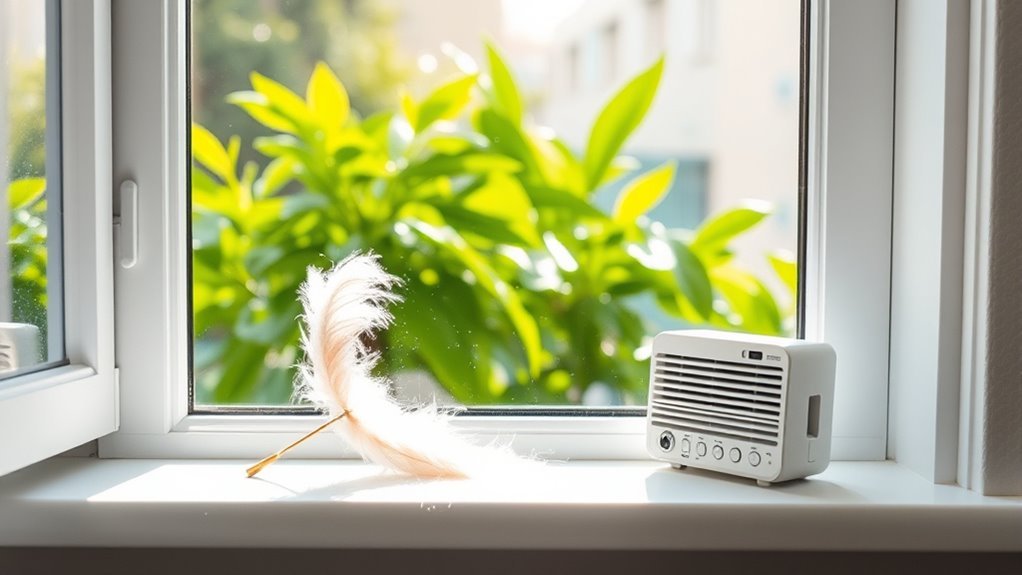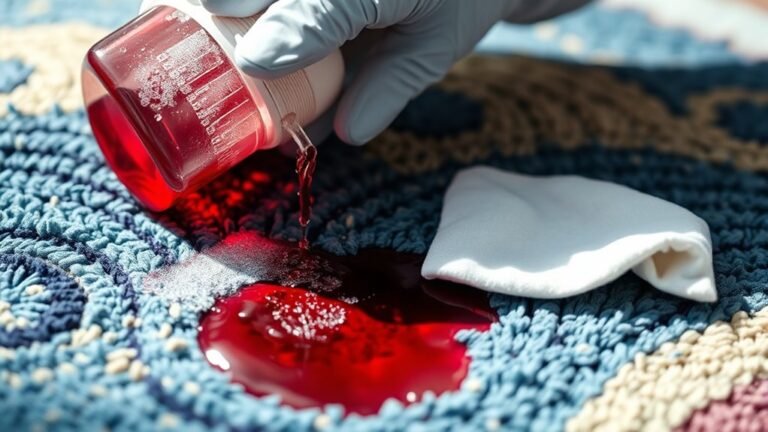Preventing Dirt Buildup on Windowsills
To prevent dirt buildup on your windowsills, stay consistent with quick daily wipes using a microfiber cloth and spot clean sticky areas promptly. Use soft brushes or handheld vacuums for dust removal, and consider applying a protective sealant to block moisture and dirt. Improving indoor air quality with proper ventilation and weatherproofing also helps reduce dust entering your home. Manage humidity to avoid mold, and small daily habits keep your space fresh. Keep going to explore more tips that make maintenance even easier.
Understanding the Causes of Dirt Accumulation

Although windowsills might seem like simple surfaces, they tend to collect dirt quickly because they’re exposed to both indoor dust and outdoor debris. You’ll notice dirt sources vary—from airborne dust particles drifting in through open windows to soil and pollen carried by the wind. Inside, you’re also dealing with dust particles from everyday activities like cooking, cleaning, or even pet dander. Understanding these causes helps you see why windowsills become dirt magnets so fast. It’s not just neglect; it’s the natural flow of particles settling in a spot that’s constantly exposed. When you recognize where the dirt comes from, you gain the freedom to tackle the problem more effectively and keep your windowsills cleaner for longer.
Choosing the Right Cleaning Tools
You’ll want to pick cleaning tools that gently remove dirt without damaging your windowsills. Soft brushes are perfect for dusting hard-to-reach corners, while microfiber cloths trap dirt effectively without scratching surfaces. Using these tools makes your cleaning routine easier and helps keep your windowsills looking fresh longer.
Soft Brushes for Dust
A soft brush is one of the best tools you can use to remove dust from windowsills without causing scratches or damage. When selecting soft bristle types, look for natural fibers like horsehair or high-quality synthetic bristles—they’re gentle yet effective. These brushes allow you to reach into corners and crevices, making dust removal techniques more efficient. You’ll appreciate how easily they loosen and lift dirt without pushing it around. Using a soft brush gives you the freedom to clean thoroughly without worrying about harming delicate surfaces. Just remember to shake out or rinse the brush regularly to avoid redistributing dust. With the right soft brush in hand, maintaining spotless windowsills becomes a simple, satisfying part of your routine.
Microfiber Cloth Benefits
Soft brushes do a great job loosening dust, but when it comes to wiping away dirt and grime, microfiber cloths really shine. You’ll appreciate the microfiber cloth advantages, like their ability to trap particles without harsh chemicals, giving you a cleaner windowsill while staying eco-friendly. Plus, microfiber cloth types vary — from plush to flat-weave — letting you pick the perfect texture for your surface and dirt level. Using the right type means less effort and better results, freeing you from stubborn stains and repetitive scrubbing. Choosing microfiber cloths empowers you to maintain spotless windowsills effortlessly, keeping your space fresh without sacrificing your time or the environment. It’s a small change that offers big freedom in your cleaning routine.
Establishing a Regular Cleaning Schedule

Keeping your windowsills clean is much easier when you set a regular schedule for it. By deciding on a cleaning frequency that fits your lifestyle, you gain control over your space without feeling overwhelmed. Whether it’s once a week or biweekly, consistency prevents dirt buildup and keeps your home fresh. Use scheduling reminders on your phone or calendar to stay on track effortlessly. These little nudges help you maintain your freedom from chaotic chores while ensuring your windowsills stay spotless. Remember, the key is to make cleaning a simple, manageable habit rather than a dreaded task. This way, you enjoy a cleaner home without sacrificing your time or freedom.
Using Protective Sealants on Windowsills
You can protect your windowsills from dirt buildup by applying the right sealant. There are several types, like silicone or polyurethane, each with specific benefits depending on your windowsill material. Make sure you apply the sealant evenly and follow the manufacturer’s instructions for the best results.
Types of Sealants
Although dirt and moisture are constant threats to your windowsills, applying the right sealant can create a strong barrier that prevents buildup and damage. You’ve got options like silicone sealants, which are flexible, waterproof, and great for outdoor use. Acrylic sealants, on the other hand, are paintable and ideal for indoor windowsills where aesthetics matter.
| Sealant Type | Key Features |
|---|---|
| Silicone Sealants | Waterproof, flexible, durable |
| Acrylic Sealants | Paintable, easy to clean |
| Polyurethane | Strong adhesion, weather-resistant |
| Butyl Rubber | Excellent for sealing gaps |
Choosing the right sealant means you’re giving your windowsills the freedom to resist dirt and last longer with less maintenance.
Application Tips
Selecting the right sealant is just the first step; applying it correctly guarantees your windowsills stay protected from dirt and moisture. To get started, make sure the surface is clean and dry—this sets the stage for a strong bond. Use a steady hand to apply the sealant evenly, avoiding excess that can trap dirt. Let it cure fully before exposing the sill to the elements. Keep in mind that proper application reduces the cleaning frequency you’ll need later. Combine this with consistent maintenance techniques, like wiping away dust and checking for cracks, to extend protection. By mastering these steps, you maintain your windowsills’ freedom from grime and damage, giving you more time to enjoy your space without constant upkeep.
Managing Indoor Air Quality to Reduce Dust

Since dust often comes from indoor air, managing its quality is key to keeping your windowsills clean. You can start by improving ventilation—open windows when weather permits and use exhaust fans to clear out stale air. A good air purifier with a HEPA filter traps dust particles, preventing them from settling on surfaces. Regularly changing HVAC filters also helps reduce airborne dust. Keep humidity levels balanced; too much moisture encourages dust mites, while too little lets particles float freely. By controlling these factors, you not only cut down on dust buildup but also create a healthier indoor environment. Taking charge of your indoor air means less time cleaning and more freedom to enjoy your space without constant dust worries.
Implementing Weatherproofing Measures
When you seal gaps and cracks around your windowsills, you prevent dirt, dust, and moisture from sneaking inside. Weather stripping is a simple, effective way to create a tight barrier, blocking unwanted particles and drafts. You don’t have to settle for uncomfortable air leaks or constant cleaning. By applying weather stripping, you take control of your space, keeping it cleaner and more comfortable.
Additionally, using insulation techniques around your windowsills strengthens this defense. Adding foam or caulk to vulnerable spots stops dirt from accumulating and helps maintain your ideal indoor climate. These weatherproofing measures aren’t just about cleanliness—they’re about reclaiming your freedom from constant upkeep and discomfort. With these steps, your windowsills stay cleaner longer, giving you more time to enjoy life on your terms.
Incorporating Plants to Minimize Dust
Although weatherproofing helps reduce dirt buildup, incorporating plants near your windowsills can further minimize dust in your home. When you focus on smart plant selection, you’re not just adding greenery—you’re inviting natural air purifiers into your space. Air purifying plants like spider plants, peace lilies, or snake plants trap dust particles and improve indoor air quality. Position these plants close to windowsills where dust tends to settle the most. This natural barrier reduces the amount of dirt that settles on surfaces, cutting down your cleaning time. Plus, caring for these plants gives you a small daily routine that connects you with nature and freedom inside your home. Choosing the right plants means you can enjoy cleaner windowsills effortlessly, making your living space fresher and more inviting.
Preventing Moisture Build-up and Mold
If you want to keep your windowsills clean and healthy, preventing moisture build-up is key. Excess moisture invites mold, which can damage surfaces and affect your freedom to enjoy a fresh home. Here’s how you can master moisture control and mold prevention:
Prevent moisture build-up on windowsills to avoid mold and keep your home fresh and healthy.
- Keep windows properly sealed to stop drafts that bring in humidity.
- Use a dehumidifier or air conditioner to maintain balanced indoor humidity levels.
- Wipe down your windowsills regularly, especially after rain or condensation.
- Ascertain good ventilation by opening windows or using exhaust fans to reduce trapped moisture.
Tips for Quick Daily Maintenance
Keeping moisture in check helps prevent mold, but staying on top of daily dirt and dust is just as important to maintain clean windowsills. To keep your windowsills fresh with minimal effort, incorporate quick techniques into your daily routines. For example, grab a microfiber cloth each morning to wipe away any dust or debris that settled overnight. You can also keep a small handheld vacuum nearby for swift removal of crumbs or dirt. These simple acts only take a minute but prevent buildup over time, giving you more freedom from deep cleaning sessions. If you spot any sticky spots, a damp cloth with mild soap works wonders without hassle. By sticking to these quick techniques daily, your windowsills stay clean, letting you enjoy a fresher, freer living space every day.
Frequently Asked Questions
Can Pets Contribute to Dirt Buildup on Windowsills?
Yes, pets can definitely contribute to dirt buildup on windowsills. If your furry friend spends time near windows, their fur, dirt from outside, and even paw prints can accumulate. Regular pet grooming helps reduce shedding, and paying attention to your pet’s indoor habits—like avoiding dirty paws indoors—can keep things cleaner. You don’t have to feel confined by constant cleaning; small habits can give you freedom from dirt buildup without much hassle.
How Does Window Type Affect Dirt Accumulation?
Your window type plays a big role in dirt buildup because different window materials attract and hold onto dirt differently. For example, wooden frames might trap more dust and need more frequent cleaning than vinyl or aluminum. If you want to keep things low-maintenance and enjoy your freedom, choosing materials that require less cleaning frequency is smart. That way, you won’t be stuck scrubbing all the time, and your windows will stay cleaner longer.
Are Certain Paints Better for Windowsill Dirt Resistance?
You might think all paints are the same, but they really aren’t when it comes to dirt resistance. Choosing the right paint types with smooth, glossy surface finishes can make a big difference. Glossy or semi-gloss paints repel dirt better and make cleaning easier, giving you more freedom from constant maintenance. Matte finishes tend to trap dust and grime, so if you want to keep your windowsills cleaner with less effort, go for those slicker surface finishes.
Does Outdoor Landscaping Impact Windowsill Cleanliness?
Absolutely, your outdoor landscaping plays a big role in how clean your windowsills stay. If you choose landscaping materials like gravel or mulch, they can reduce dirt and dust blowing onto your windowsills. Plus, regular outdoor maintenance—like trimming plants and clearing debris—helps keep things tidy. By managing your landscape thoughtfully, you’ll enjoy less dirt buildup and more freedom to relax without constant cleaning interruptions.
Can Air Purifiers Reduce Windowsill Dust Specifically?
You might wonder if air purifiers can cut down windowsill dust specifically. Their effectiveness depends on dust particle size; most purifiers trap tiny particles, reducing airborne dust before it settles. While they won’t eliminate all buildup, they can help keep your space cleaner, giving you more freedom from constant cleaning. So, using a good air purifier can definitely make a noticeable difference in managing dust around your windowsills.






